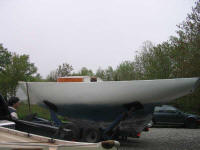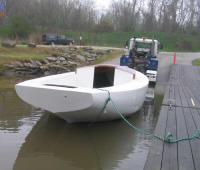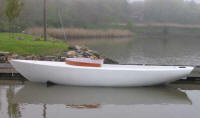
|
|
~MENU~ |
| Home |
| The Concept |
| The Boat |
| Bringing Her Home |
|
Weekly Progress Log |
|
Daysailor Projects |
| The Boat Barn |
| Resources |
| Other Sites |
| Email Tim |
|
|
|
From a Bare Hull: Striking the Waterline |
|
I knew all along that the boat would probably
not float at her originally-designed waterline. Even stock Tritons
rarely float properly at this line, tending to sag in the stern and, in
general, riding much lower in the water than the original design
intended. Therefore, I questioned where, exactly, I would strike the new waterline on this heavily-modified boat. While I had retained the most essential design elements--hull shape, ballast weight, and rig dimensions--everything else was different. I felt that I had distributed the new structure and machinery quite evenly and symmetrically, but still, the actual waterline remained a mystery. How would she float? |
|
Eventually, I came to the conclusion that the only way to tell where the boat floated was to actually float her. Of course, to do this accurately meant that the boat had to be in an advanced stage of completion before the test could occur. The concept seemed silly: haul the boat from the shop, launch her, mark the waterline, and return the boat to the shop, all in short order. However, I could come up with no other feasible means of determining this. Too many calculations, requiring too much information that was not at hand, were required--and, most importantly, these calculations would require design and engineering skills that I did not possess, and that I had no desire to ever possess. |
|
By late April and early May, the boat was complete enough that I could make the decision to try and schedule a test launch. The engine and systems were in, the interior was more or less finished, and the main structural work was all complete. The through hulls and seacocks were in, and the boat was watertight--or at least she would be with the addition of a propeller shaft and stuffing box, or at least some sort of temporary plug in the stern tube hole. |
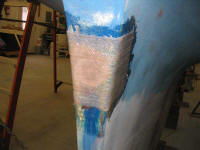 After
some phone tag, I eventually scheduled the test launch for Tuesday
morning, May 31, with a pickup at 0700. Since I did not yet have
my shafting, I ended up sealing the shaft hole with a single layer of
fiberglass that I slapped over from outside, purely as a temporary
measure. For further preparations, I removed excess tools and gear
from the boat, and made sure everything was secure and ready to go.
Please note in the photos that the boat is incomplete and lacks
toerails, deck paint, other wooden deck trim, cockpit coamings, and many
final details. Consider this a sneak peek. After
some phone tag, I eventually scheduled the test launch for Tuesday
morning, May 31, with a pickup at 0700. Since I did not yet have
my shafting, I ended up sealing the shaft hole with a single layer of
fiberglass that I slapped over from outside, purely as a temporary
measure. For further preparations, I removed excess tools and gear
from the boat, and made sure everything was secure and ready to go.
Please note in the photos that the boat is incomplete and lacks
toerails, deck paint, other wooden deck trim, cockpit coamings, and many
final details. Consider this a sneak peek. |
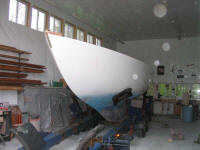 On
the appointed morning, my boat hauler picked the boat up at the shop.
It seemed strange to be moving the boat after so much time, and when not
fully complete as well, but nonetheless it was nice to see her emerge
from the shop and into daylight, where I could begin to get a real sense
of her aesthetics. On
the appointed morning, my boat hauler picked the boat up at the shop.
It seemed strange to be moving the boat after so much time, and when not
fully complete as well, but nonetheless it was nice to see her emerge
from the shop and into daylight, where I could begin to get a real sense
of her aesthetics. |
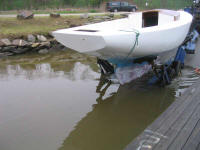 At
the launching ramp, Steve backed the boat into the water and then held
her loosely in the trailer's hydraulic arms to prevent her from
moving away, though we also had two lines to the boat. I could tie
a bow line to the stem fitting, but with no deck hardware on board and
nothing to tie to, I had to loop the stern line through the rudder tube
and tie it around the side of the boat with a bowline. At
the launching ramp, Steve backed the boat into the water and then held
her loosely in the trailer's hydraulic arms to prevent her from
moving away, though we also had two lines to the boat. I could tie
a bow line to the stem fitting, but with no deck hardware on board and
nothing to tie to, I had to loop the stern line through the rudder tube
and tie it around the side of the boat with a bowline. |
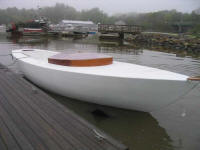 When
the boat was floating free of the trailer, I took a few moments to take
some photographs and check out how the boat looked. I was quite
pleased, and noted that she floated higher than I had expected.
Earlier, I had prepared a long stick with a black permanent marker taped
to the end, and now I used this to mark the waterline at the centerline
bow and stern--the two reference marks I would need later to strike an
accurate and level waterline. My little stick contraption worked
well. When
the boat was floating free of the trailer, I took a few moments to take
some photographs and check out how the boat looked. I was quite
pleased, and noted that she floated higher than I had expected.
Earlier, I had prepared a long stick with a black permanent marker taped
to the end, and now I used this to mark the waterline at the centerline
bow and stern--the two reference marks I would need later to strike an
accurate and level waterline. My little stick contraption worked
well. |
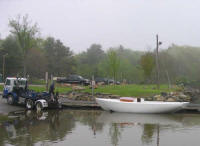 I
took a few more minutes to eye the boat critically from all angles
possible, to determine whether I thought the boat was in proper trim as
is, or whether any trim ballast might be required. I thought she
looked good, and proportionately correct, but I took a series of photos
that I could eye critically later on to confirm my initial impressions. I
took a few more minutes to eye the boat critically from all angles
possible, to determine whether I thought the boat was in proper trim as
is, or whether any trim ballast might be required. I thought she
looked good, and proportionately correct, but I took a series of photos
that I could eye critically later on to confirm my initial impressions. |
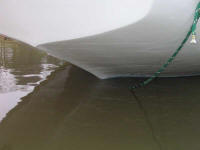 With
that, the test launch was complete, and soon the boat was back on the
trailer and free from the water once again. I noted that the new
marks were nearly 3" lower than the original molded scribe marks bow and
stern, indicating that the boat was substantially lighter than before.
The new marks seemed to be equally below the originals, confirming my
impression that the boat was floating visually level. With
that, the test launch was complete, and soon the boat was back on the
trailer and free from the water once again. I noted that the new
marks were nearly 3" lower than the original molded scribe marks bow and
stern, indicating that the boat was substantially lighter than before.
The new marks seemed to be equally below the originals, confirming my
impression that the boat was floating visually level. |
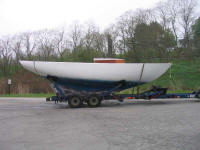 By
0830, the boat was back in the shop as if nothing had happened. By
0830, the boat was back in the shop as if nothing had happened.Next: striking the actual waterline. Click here to continue.>
|
|
Back to Main Menu> |

